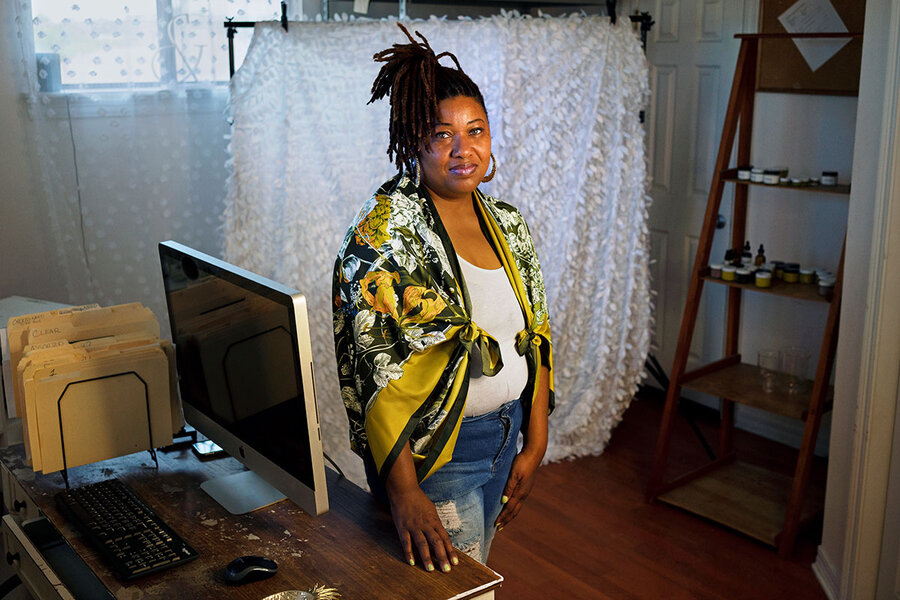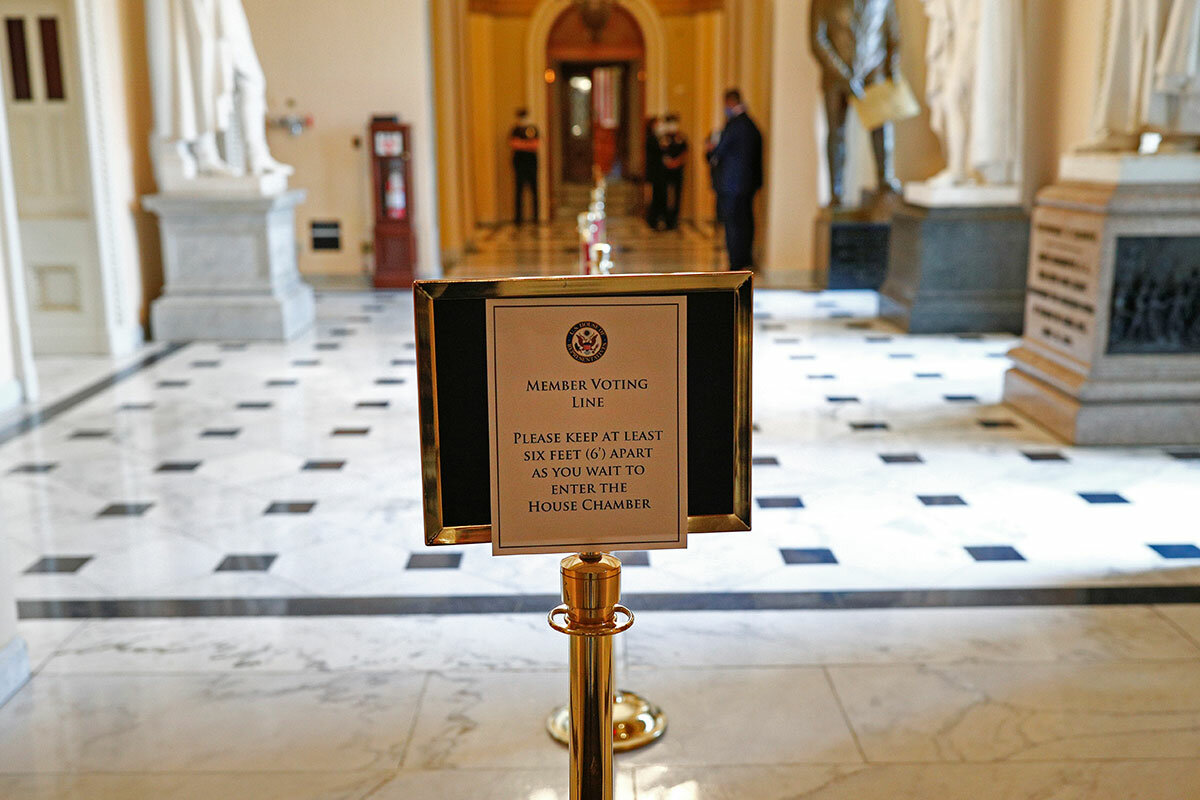Aid for US economy is expiring – at just the wrong moment
Loading...
| Wellesley, Massachusetts
When the coronavirus hit this spring, Souren and Susan Etyemezian made a sweeping decision to close three of their specialty nut stores – all in high-end locations around Boston – and consolidate around their store in middle-income Watertown.
It’s a sign of the topsy-turvy nature of the coronavirus recession. The closed Fastachi nut store in posh Wellesley is stripped nearly bare; even the counter is gone, leaving electrical wires sticking out from the base. At a nearby intersection, 4 of 10 shops are either empty or advertising for tenants.
In this downturn, it’s rich people who have cut back spending the most, according to new research. But the threat to businesses and jobs is nationwide, affecting communities of all income levels. And now, the U.S. economy is reaching a critical juncture.
Why We Wrote This
No one likes the idea of an economy propped up by emergency support. But, with a rise in coronavirus cases hindering efforts at reopening and revival, pressure is rising on Congress for a new round of aid.
Editor’s note: As a public service, all our coronavirus coverage is free. No paywall.
Emergency relief programs, passed by Congress this spring, are about to phase out, potentially undercutting consumer spending still further. And with coronavirus caseloads rising rather than falling across much of the nation, the rising risk is that legions of businesses can’t wait out the slump, and close their doors permanently. The urgent question is: What will it take to bring back the economy?
Beating the pandemic is, increasingly, the obvious necessity. Yet, since that doesn’t look like a quick task, policy experts say new rounds of federal support are also vital, especially as the boost from one-time stimulus checks fades and as $600-per-week supplemental support for jobless Americans is poised to end on July 31.
“A one-time check helps for that one time, but that’s it,” says Orson Aguilar, economic policy director of UnidosUS, a Latino advocacy organization.
“I don’t think anybody is wedded to $600,” he adds. “It could be $400 or $500.” But the economic package has to include ongoing benefits, such as unemployment, he says.
Hispanics have an unemployment rate that, at 14.5% in June, is second only to African Americans (15.4%) among major ethnic and racial groups.
Inaction carries big risks
As Congress reconvenes to consider a new round of relief and stimulus, policymakers don’t have a lot of time to wait around to see whether the forces of recovery will outweigh the forces of recession, researchers say. If the federal government doesn’t step in soon, the recovery could give way to a new downturn.
The goal of relief, as in the spring, would be twofold: to help millions of people whose incomes have been decimated, and also to prop up the wider economy so as many employers as possible can survive the pandemic.
A month or two ago, many Americans thought it wouldn’t take that long. The White House and its allies pushed the idea that states should reopen early because the United States faced a trade-off between combatting the coronavirus and revving the economy.
But researchers at Harvard University and elsewhere have found that reopening orders by governors had little impact on employment and that consumers, especially in hard-hit wealthy places, cut back spending because they wanted to avoid high-traffic, high-contact shopping. As of July 8, consumer spending in low-income ZIP codes was down an average 1.9% from the January level before the pandemic; in high-income ZIP codes, it was down 10.8%.
That doesn’t mean residents of Wellesley, where the average household income exceeds $275,000, are bearing the brunt of the downturn. It’s the town’s small-business owners and, especially, their employees who are.
“In the end, people are paying attention to the risk of COVID,” says Michael Stepner, an economist and Harvard post-doctoral fellow who co-authored the new research. “Those reopenings are ultimately going to be driven by improvements in public health, and that’s the only sustainable way for the economy to recover.”
As states struggle to contain the COVID-19 pandemic, the onus falls on Congress to provide a new round of relief.
Speed versus precision
The bipartisan $2 trillion CARES Act, which in April sent relief checks to families and made loans available to businesses, helped spark an economic rebound in May, but not to pre-pandemic levels.
“Absent those programs, things would have been quite a bit worse,” says Vadim Elenev, an economist at Johns Hopkins University’s business school who studies financial crises. But federal rescue efforts have cost much more than an ideally targeted program, he says, citing his own research with other economists.
Yet crafting cheaper, more targeted programs – such as to help small businesses stay afloat and avoid layoffs – is hard. Experts say it would involve government picking and choosing which industries, and perhaps which businesses, need federal support.
For example, many say the government shouldn’t be wasting money on businesses that would go bankrupt anyway. So should the government help Wellesley Town Taxi? Having already lost its local business to ride-hailing companies like Uber, the company remade itself into an airport limo service. But when the pandemic slammed the airline business, demand for airport rides evaporated.
For now, the most important thing is to get the relief out speedily, says Dan Sichel, a professor of economics at Wellesley College and former Federal Reserve economist.
“The more one tries to get things targeted, the more difficult it is to get those checks out quickly,” he says.
Partisan divide in Congress
Getting money to needy individuals is much easier than aid to businesses – and has proved more effective. But here again, big decisions loom for Congress over targeting and total dollars.
The Democratic-controlled House has already passed a $3 trillion package that would expand relief-check amounts that low- and middle-income families with children would receive. And the Trump administration has signaled support for another round of checks, but it’s unclear if the Republican-controlled Senate will go along with such a generous package when it reconvenes next week.
Another battle is shaping up over extending special unemployment benefits. With an extra $600 a week for the unemployed, researchers found that two-thirds of recipients were earning more from unemployment than when they were working, which has drawn widespread criticism.
“The $600 weekly unemployment bonus has caused a not-insignificant number of businesses to have a hard time getting their employees to return to work,” writes Rachel Greszler, a research fellow at The Heritage Foundation.
Yet many economists see a strong case for some level of expanded benefits, given that the 11.1% unemployment rate as of June remains higher than at any time since the Great Depression.
Whatever Congress does, economic relief is at best a partial plan for reviving the economy. Flattening the pandemic is key, and the survival of businesses hangs in the balance.
The toll on businesses
Even if state and local governments allow businesses to open, the social-distancing restrictions can make it difficult for stores to reopen. That’s one reason the White family closed its popular small bakery and café in Wellesley, which had been in operation less than a year. “With social distancing, we didn’t want to open,” says Brian White, manager of White’s Bakery and Café.
Fear of the pandemic could suppress demand for some businesses for months to come. “It looks like reopening dates have been pushed out,” says Christopher Stanton, an economist at Harvard Business School who studies entrepreneurship.
Using surveys from Alignable, an online network for small business owners, he says half of small businesses have fully reopened, with the same products and services as before the crisis. But another third have reopened with fewer or different products and services, and 15% remain temporarily closed. When the latter two groups were asked in a survey in late June when they expected to fully reopen, 60% said September or later.
Souren Etyemezian says he and his wife are now pushing to boost online sales for their Fastachi nut company to help make up for the reduced store sales.
“We didn’t feel retail is going to come back as it used to be at least for two years,” he says.
Editor’s note: As a public service, all our coronavirus coverage is free. No paywall.







